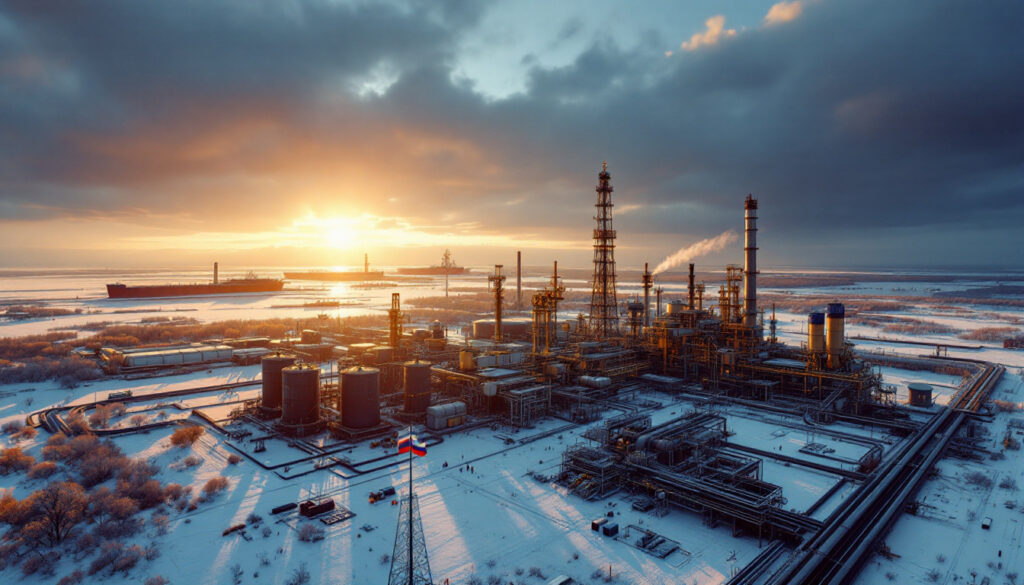Russia's Energy Strategy: Crude Oil Production and Export Outlook to 2050
Russia's newly published energy strategy outlines a conservative approach to crude oil production, aiming to stabilize output at approximately 10.84 million barrels per day (540 million tons annually) through 2050. This plan reflects a deliberate shift from expansion to market stability, acknowledging global energy transition pressures and geopolitical constraints. By maintaining existing production levels, Russia seeks to preserve its 10% share of global crude output while adapting to evolving sanctions and technological challenges. The strategy's emphasis on predictability aligns with OPEC+ collaboration goals but raises questions about long-term competitiveness amid declining global oil demand forecasts.
Understanding Russia's New Energy Strategy
Current Production Capacity and Global Influence
Russia currently produces approximately 10.84 million barrels of crude oil per day, equivalent to 540 million tons annually, representing roughly 10% of global crude output. This significant market share gives Russia considerable influence in international energy markets, allowing it to affect global pricing through production decisions. The 2023 production levels serve as the baseline for Russia's new long-term energy strategy, which prioritizes stability over growth.
Russian oil fields are predominantly mature, with many Western Siberian assets experiencing natural decline rates of 5-7% annually. Despite these challenges, enhanced recovery techniques have helped maintain output levels, though at increasing operational costs. The country's position as a swing producer alongside Saudi Arabia has historically provided leverage in OPEC+ negotiations, though sanctions have somewhat diminished this influence.
Strategic Vision and Timeline
The new strategy outlines Russia's energy development plans through 2050, with the document published on April 14, 2025. Rather than pursuing ambitious production growth, the strategy focuses on maintaining stable production levels over the next quarter-century. This approach signals a recognition of both practical limitations and strategic advantages to a steady-state production model.
Energy Minister Nikolai Shulginov has emphasized that "infrastructural resilience takes precedence over volume growth" in Russia's planning, suggesting a shift from Soviet-era production maximization philosophies. The timeline allows for gradual technological adaptation while preserving Russia's position as a major energy supplier during the global transition period.
What Does Russia's Long-Term Oil Production Plan Reveal?
Production Targets Through 2050
Russia's target scenario maintains crude output at 540 million tons (10.84 million barrels/day) by 2030, with production expected to remain at this level through 2050. This represents only a marginal increase of approximately 1.2% from 2023 baseline volumes, revealing a strategy focused on sustainability rather than expansion.
The stable production target acknowledges several realities: declining output from legacy fields, technological constraints due to sanctions, and the capital-intensive nature of Arctic and East Siberian greenfield development. With a reserve replacement ratio of 90% in 2023—below the 100% threshold needed for sustained long-term production—Russia faces challenges in maintaining this plateau without significant technological breakthroughs or investment increases.
Export Projections
Foreign shipments are anticipated to hold steady through the forecast period, with no significant expansion of export capacity planned. This strategy suggests a focus on maintaining market share rather than growth, particularly in Asian markets where Russia has redirected much of its crude following Western sanctions.
The export outlook is complicated by changing trade patterns, with approximately 60% of tankers servicing Russian exports now classified as the "shadow fleet"—vessels operating outside conventional insurance and shipping channels. Currency settlements have also shifted dramatically, with 80% of 2024 transactions conducted in yuan or rupees rather than dollars or euros, reflecting adaptation to financial sanctions.
How Does This Strategy Reflect Russia's Energy Market Position?
Market Stability vs. Growth
The strategy emphasizes stability and sustainability over aggressive expansion, suggesting Russia may be acknowledging peak oil demand scenarios projected by various energy agencies. This focus on value maximization rather than volume growth aligns with global commodities insights, though Russia's timeline appears more conservative than Western projections.
With a budget breakeven price of approximately $45 per barrel—above current Urals prices of $38-42—Russia faces fiscal challenges even with stable production. The strategic pivot toward maintained rather than increased output suggests realistic assessment of market constraints and perhaps recognition that flooding markets with additional barrels would be counterproductive to price stability.
Geopolitical Considerations
Stable production targets reflect adaptation to international sanctions, particularly technological restrictions affecting deepwater, Arctic, and shale development. The strategy likely accounts for shifting global energy transition policies, including the EU's Carbon Border Adjustment Mechanism which could impact refinery export economics.
Russia's increasing reliance on Asian markets—with China now receiving 35% of exports compared to 25% in 2020—demonstrates successful market reorientation despite logistical challenges. This east-facing strategy represents Russia's long-term vision for maintaining energy influence even as traditional European markets diminish, requiring investors to adapt their geopolitical shift strategies.
What Are the Implications for Global Oil Markets?
Supply Predictability
Russia's stable production outlook provides predictability for global markets, potentially helping to balance global supply-demand dynamics during the energy transition period. This consistency signals Russia's intent to remain a major player despite energy transition pressures, particularly in developing markets where demand growth is expected to continue.
The International Energy Agency suggests that while global oil demand may peak in the early 2030s, the decline phase will likely be gradual rather than precipitous. Russia's conservative planning aligns with this assessment, positioning the country to supply reliable volumes during the multi-decade transition while other producers may pursue more aggressive divestment strategies.
Price Implications
Stable Russian production could support price stability if aligned with global demand trends. The strategy suggests Russia is not planning to flood markets with additional supply, which would depress prices and undermine fiscal sustainability. This approach may indicate continued coordination with other major producers on market management, particularly within the OPEC+ framework.
As IEA analyst Laura Cozzi notes, "Russia is betting on demand longevity in emerging markets, but underinvestment risks mid-century supply gaps." This observation highlights the balance Russia seeks between near-term market share preservation and long-term positioning in a potentially contracting market, a dynamic that creates unique market dynamics explained by investor behavior.
FAQ: Russia's Energy Strategy and Global Oil Markets
How does Russia's oil production compare to other major producers?
Russia's 10.84 million barrels per day makes it one of the world's top three oil producers, with output comparable to Saudi Arabia and the United States. This production volume represents approximately 10% of global crude output, giving Russia significant influence in international markets despite sanctions.
Unlike Saudi Arabia, which maintains substantial spare capacity (approximately 3 million bpd), Russia typically operates near full capacity. Russian crude also has a higher average carbon intensity—18 kg CO₂ per barrel compared to Saudi Arabia's 14.5 kg—creating potential vulnerability to carbon border adjustment mechanisms in importing countries, according to recent data from the IEA.
What factors could disrupt Russia's stable production outlook?
Technological limitations due to sanctions represent the most significant challenge, particularly for complex reservoirs requiring Western fracking, horizontal drilling, or enhanced recovery techniques. As Rystad Energy's Daria Melnik observes, "Technological sovereignty in fracking remains Russia's Achilles' heel."
Additional disruption risks include accelerated global energy transition, domestic policy shifts following leadership changes, geopolitical developments affecting export markets, and investment constraints in production infrastructure. The average water cut in West Siberian fields has reached 82%, requiring approximately $2 billion annually in treatment costs—a technical challenge that will intensify without access to advanced separation technologies.
How might Russia's strategy impact OPEC+ dynamics?
Russia's commitment to stable production signals alignment with OPEC+ objectives of market management rather than market share maximization. This approach suggests continued coordination on production levels, though Russia's compliance with agreed cuts has historically been less consistent than Saudi Arabia's (92% versus 104% compliance in 2023).
The long-term strategy indicates Russia's commitment to oil market management frameworks, potentially supporting OPEC+ cohesion during demand uncertainty periods. However, as production becomes more challenging technologically, Russia's ability to adjust output in response to OPEC+ agreements may diminish, potentially straining the arrangement.
Russia's Oil Industry: Current State and Future Challenges
Production Infrastructure
Current production relies heavily on established fields with well-developed infrastructure, particularly in Western Siberia where the Yuganskneftegaz unit alone accounts for 1.2 million barrels per day. The strategy implies sufficient investment to maintain but not significantly expand capacity, focusing on efficiency improvements rather than greenfield development.
With 2.3 million workers employed in the oil and gas sector—approximately 15% nearing retirement age—workforce challenges compound technological constraints. Refinery utilization rates have declined to 78% following EU product import bans, creating downstream bottlenecks that could eventually affect upstream production decisions.
Technological Considerations
The strategy must account for limitations on access to Western technology, particularly for enhanced oil recovery and complex reservoir development. This reality implies increased focus on developing domestic capabilities or forming alternative partnerships with non-Western technology providers.
Digitalization lags behind global standards, with 40% of upstream operations using IoT sensors compared to 65% globally. Some companies are innovating despite constraints—Tatneft's microbial enhanced oil recovery trials and Gazprom Neft's AI-driven reservoir modeling initiatives represent promising developments, though implementation at scale remains challenging amid what many analysts consider an emerging commodity super cycle.
Conclusion: Strategic Implications of Russia's Energy Plan
Market Positioning
Russia is positioning itself as a stable, reliable supplier through 2050, reflecting a pragmatic assessment of the global energy transition timeline. This strategy indicates confidence in continued oil demand despite decarbonization trends, particularly in developing Asian economies where alternatives face infrastructure and cost constraints.
The carbon intensity of Russian production (averaging 18 kg CO₂ per barrel) presents a competitive disadvantage in markets implementing carbon pricing or border adjustments. However, the strategy's timeframe suggests Russia anticipates these mechanisms will evolve gradually enough to allow adaptation rather than requiring immediate transformation, a position that stands in contrast to Trump's energy policies for the U.S. market.
Economic Planning
Energy strategy remains closely tied to Russia's broader economic planning, with stable oil revenues central to fiscal policy. With 45% of the 2024 federal budget derived from oil and gas revenues, the strategy suggests gradual rather than abrupt transition away from hydrocarbon dependence.
Investment in energy transition technologies remains modest by Western standards, with $3 billion allocated for hydrogen R&D through 2030. As Stanford's Mark Zoback warns, "This strategy assumes oil remains central to global energy systems through 2060—a risky bet." The conservative production outlook may provide stability, but potentially at the cost of positioning Russia at the trailing edge of energy innovation.
Want to Spot the Next Major Mineral Discovery?
Discover how significant ASX mineral discoveries can lead to exceptional returns using Discovery Alert's proprietary Discovery IQ model, which transforms complex mining data into actionable investment insights. Explore historic examples of remarkable investment outcomes by visiting the Discovery Alert discoveries page and start your 30-day free trial today.




